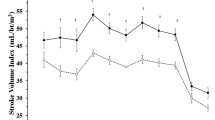Abstract
Impedance cardiography (ZCG), a noninvasive technique used to determine stroke volume and ventricular performance, is currently being utilized more extensively in psychophysiological research and may also prove a useful tool in the control of hypertension. To date, most studies employing ZCG have tested male subjects or patients. However, women and men differ on two important parameters used to calculate stroke volume: thoracic impedance (Zo), and the first derivative of change in impedance over time (dZ/dtmin). Examination of the clinical records of 19 females and 19 males, all nonmedicated, indicated that women had higher Zo levels (F(1, 36)=46.2,p<.0001) and higher dZ/dtmin levels (F(1, 36)=51.8, p<.0001), although calculated stroke volume indexes did not differ. A second sample of 10 women and 8 men, all healthy and nonmedicated, confirmed these findings. The differences in Zo are not due entirely to sex differences in height, weight, percent body fat, and subscapula skin-fold thickness, although these factors differ across sexes. It is important for researchers and clinicians utilizing ZCG with female subjects to be aware of these differences.
Similar content being viewed by others
References
Buell, J. C., McKinney, M. E., Myers, D., Beck, B., & Eliot, R. S. (1983). The validity of impedance cardiography.Psychophysiology, 20 420. (Abstract).
Frey, M. A. B., Doerr, B. M., & Miles, D. S. (1982). Transthoracic impedance: Differences between men and women with implications for impedance cardiography.Aviation, Space, and Environmental Medicine, 53 1190–1192.
Katch, F. I., Behnke, A. R., & Katch, V. L. (1979). Estimation of body fat from skin-folds and surface area.Human Biology, 51 411–424.
Kubicek, W. G., Karnegis, J. N., Patterson, R. P., Witsoe, D. A., & Mattson, R. H. (1966). Development and evaluation of an impedance cardiac output system.Aerospace Medicine, 37 1208–1212.
Mathews, D. K., & Fox, E. L. (1981).The physiological basis of physical education and athletics (2nd ed., pp. 446–476). Philadelphia: Saunders.
McKinney, M. E. (1984).The reliability and validity of impedance cardiography in a psychophysiological research laboratory. Paper presented at the 15th annual meeting of the Biofeedback Society of America, Albequerque, New Mexico.
Miller, J. C., & Horvath, S. M. (1978). Impedance cardiography.Psychophysiology, 15 80–91.
Rapaport, E. (1980). Coronary artery disease. In American Heart Association (Ed.),Heart-book: A guide to prevention and treatment of cardiovascular diseases (pp. 176–187). New York: Dutton.
Author information
Authors and Affiliations
Additional information
Special thanks to Tracy Dorheim, Larry Martin, and Karla Bergstraesser for excellent technical support. Thanks to Gloria Barton for help with manuscript preparation.
Dr. Eliot is director and Dr. Buell associate director of Preventive and Rehabilitative Cardiology at the Heart Lung Center.
Rights and permissions
About this article
Cite this article
McKinney, M.E., Rovang, K., Buell, J.C. et al. Sex-related differences in first-stage impedance cardiographic variables. Biofeedback and Self-Regulation 9, 365–370 (1984). https://doi.org/10.1007/BF00998979
Issue Date:
DOI: https://doi.org/10.1007/BF00998979




